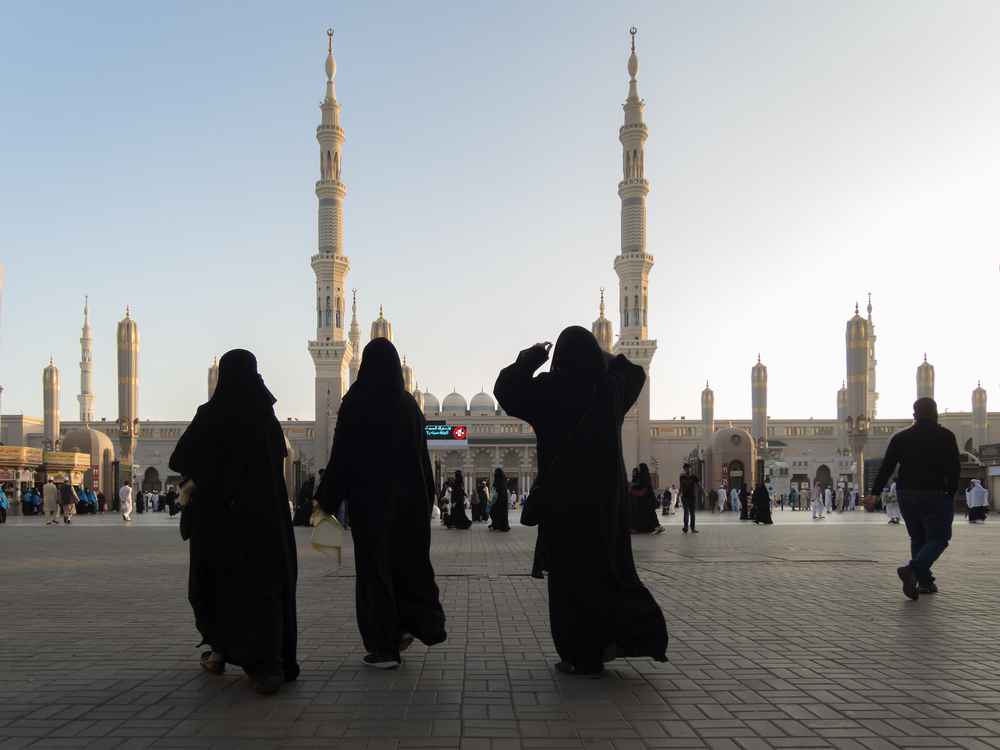Saudi Arabia’s travel and tourism revenues jump 8.6 pct, fueled by promotion of religious travel
Photo: MEDINA, SAUDI ARABIA, 4 December 2015: Silhouette of pilgrims at the Prophet Muhammad's mosque in Medina / Drpyan / Shutterstock.com
Saudi Arabia's tourism revenues jumped 8.6 percent in 2015 on the back of an increase in domestic and foreign tourists largely due to the kingdom's efforts to promote religious tourism.
The total contribution of Saudi Arabia’s travel industry to the country’s Gross Domestic Product in 2015 was 190.3 billion riyals ($50.7 billion), or 8 percent of GDP, compared to 175.2 billion riyals, or 7.7 percent of GDP, in 2014, according to the March 2016 World Travel & Tourism Council (WTTC) report.
For 2016, WTTC forecasts the kingdom's increase in total travel and tourism contribution to GDP by 4.2 percent. After that an annual rise is predicted at 4.4 percent per year to reach $81.6 billion — about 9.2 percent of GDP — in 2026, according to the Council.
Further, religious tourism to Mecca and Medina will likely increase the number of tourists interested in halal and Shariah-compliant services from 17.5 million in 2014 to 25 million by 2025, according to the latest statistics provided by Riyadh-based Aljazira Capital.
According to Aljazira, the Saudi government is meeting the demands of more visitors by continuing to strengthen its transportation infrastructure, including two major projects that are still under construction: the Haramain High Speed Rail, which will link Mecca and Medina, and the new Riyadh Metro. The government also invested heavily to expand the Prince Mohammad bin Abdulaziz Airport in Medina.
Saudi Arabia’s Commission for Tourism and National Heritage has developed a two-pronged approach to attracting Muslim visitors to the country by emphasizing religious tourism to the two holy cities of Mecca and Medina and preserving and offering tours to the kingdom’s numerous archaeological and heritage sites.
Far down on its list of priorities are efforts to attract foreign tourists from outside the GCC region.
“Religious tourism will continue to grow,” said Feton Alrefaei, an account executive with LeGate, which specializes in accommodations for hajj and umrah services. “The world is in crisis now, especially in the Middle East, but Saudi Arabia is safer and more appealing to tourists. And Saudi Arabia has been more open in the last five years.”
Dr. Erdogan Ekiz, head of the Travel and Tourism Department at King Abdulaziz University, said 65 percent of foreign visitors are on hajj and umrah visas, while 26 percent enter on family visas.
UMRAH PLUS
Ekiz said the Saudi government is taking a step further to boost religious tourism by preparing to launch its Umrah Plus program that allows hajj and umrah pilgrims to remain in the country longer.
Government regulations limit pilgrims to Mecca and Medina, but Umrah Plus, scheduled to become effective in 2017, allows them a full month in the country, as opposed to the current 15-day limit, and the ability to move more freely.
“Umrah Plus will allow visitors to explore archeological and heritage sites and visit other areas other than the two big cities,” said Ekiz.
Muslim and non-Muslim domestic and foreign tourists visiting the kingdom for recreational activities still enjoy halal and family-friendly experiences, although visits to museums and other cultural centers pale in comparison to the desire to see the two holy cities.
Last month the National Museum in Riyadh staged an exhibit on the early capitals of Islamic culture. The exhibit attracted more than 7,000 visitors, although less than half were families. The majority were visitors on official business or high school and university students, according to the tourism commission.
EMPLOYMENT OPPORTUNITIES
The increasing numbers of tourists, whether fulfilling their religious obligations or enjoying a family outing, have created a demand for the tourism commission to recruit more guides.
The commission announced this month that 4,500 Saudi citizens were employed in 80 tourism facilities under its Training Ends with Employment program. At the end of 2015, 1.2 million direct and indirect jobs were generated in the tourism industry with a forecast of 1.7 million jobs by 2020, according to the commission.
KAU’s Professor Ekiz said the commission has moved to hire more women by developing an events management program that will diversify the tourism industry’s labor force. About 200 women will participate in the program.
“It’s a humble start, but it’s the first of its kind,” he said.
© SalaamGateway.com 2016

Rob L. Wagner